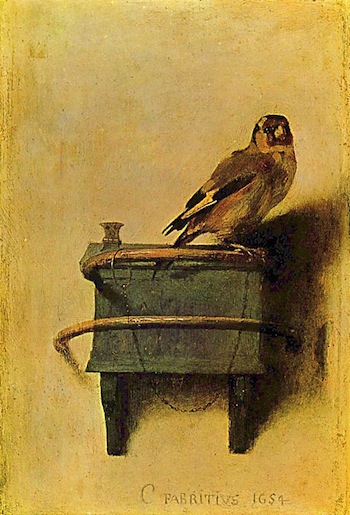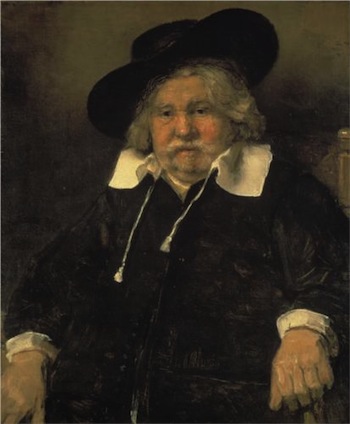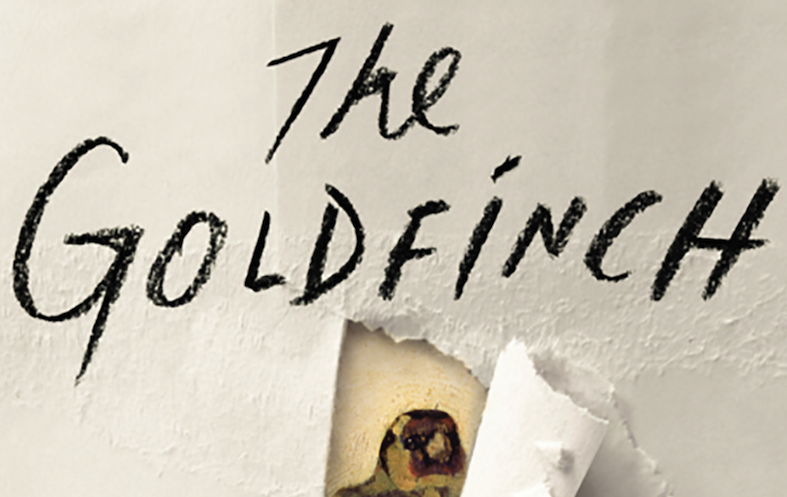Book Review: The Unwavering Gaze — Fabritius and Donna Tartt’s “The Goldfinch”
In Donna Tartt’s much-lauded third novel, Fabritius’s painting “The Goldfinch” and the fleeting nature of, well, everything come together for a brief and shining moment.
By Clea Simon
I, perhaps like many birdwatchers, am suggestible. I watch the pecks and flutters out at the feeder and flesh out the squabbles these represent. Domestic drama, romantic rivalry, you name it. Give me a junco with or without his partner, and I recast Shakespeare.
Still, I do not think it was entirely in my mind when, last Sunday at the Frick Museum in New York, I looked from Rembrandt’s Portrait of an Elderly Man over to Fabritius’s The Goldfinch and saw a resemblance.
I was one of the record crowd who had come to see Vermeer, Rembrandt, and Hals: Masterpieces of Dutch Painting from the Mauritshuis, a little gem of a show that for four months occupied two rooms of the mansion museum. One room was given over entirely to Vermeer’s Girl with a Pearl Earring. The other 14 pieces lined the adjoining East Gallery, and while I had waited for what may be my only chance ever to examine each of the pieces up close, at some point I found myself in the middle of the room, looking from one wall to the other. While the gallery was crowded – timed tickets for this last day had sold out by the time we used ours – the Frick had kept occupancy reasonable, and whether because of their planning or some trick of fate, I had a clear sight line to both paintings – the fleshy old man to my right, the tiny bird to my left – and I saw it. Something about the gaze: direct, unwavering. A little weary. In both, I saw the self-awareness of souls chained to this material world. Who had grown increasingly conscious of their bondage, had experienced the world’s cruelty as well as its beauty, and who were resigned, perhaps finally, to giving it up.
There are similarities in style in these two paintings – both painted in the mid-17th century, the height of both Dutch painting and the small nation’s material wealth. And so maybe what I noticed was simply the technique delineating those dark, smudgy eyes. The free and rough brushstrokes that gave Rembrandt’s aged merchant his big, workmanlike hands and the little bird his soft body. Maybe it was their shared pose: staring out at the viewer. Maybe it was simply their placement across a crowded room.
Because there were certainly differences in the paintings as well as similarities, distinctions beyond species or intent. For while the Rembrandt is a full bust, nearly three by two feet, of a large man slumped in a chair, the Fabritius is so small (roughly nine by thirteen inches) as to make the little bird roughly life-sized. Throw in the domestic detail – its delicate chain, which connects the bird to what is described as a feed box – and you have a much more intimate painting, something more akin to the four devotional Piero Della Francescas that are currently making up another special exhibit, Personal Encounters, up the street at the Met.
Of course, the focus of private contemplation had changed dramatically in the two hundred years between Piero and Fabritius, and the Mauritshuis exhibit particularly focused on paintings from an era of unprecedented wealth and trade. In such a world, that little house pet is just one more luxury, like a Rembrandt portrait, while a painting of such a tiny treasure is less a devotional object, a focus for thought or prayer, than a private indulgence. And yet, that bird – those dark eyes… “By the time you see this,” that little bird is saying, “I will be gone.”
That perspective may well have been influenced by the themes of author Donna Tartt’s own blockbuster, The Goldfinch, the massive bestseller that reportedly helped drive Frick attendance to record levels. In this, Tartt’s much-lauded third novel, both the Fabritius painting and the fleeting nature of, well, everything come together for a brief and shining moment.
Yes, I did say brief. Because although at 771 pages, Tartt’s book has now been more often criticized for its length than for any of its characters, diversions, or convoluted plot lines, it is still finite. And since one can never read a book for the first time twice; that pleasure is ephemeral. More’s the pity.
Tartt, who graced the opening of the show and was reportedly in attendance on that last day, makes the Fabritius painting both a truly private devotional object as well as the ultimate treasure in the contemporary cutthroat mercenary world.
Her setup would be enough to make any curator wary, and it is perhaps just as well that the Frick was unaware of the upcoming publication when this show was being planned. As The Goldfinch opens, 13-year-old Theo Decker is on his way to a school visit with his mother – he has misbehaved – when a rainstorm drives them into a museum (the Met, in Tartt’s fiction) where the tiny masterpiece is on display. While they are sheltering, a terrorist bomb explodes. (As other critics have noted, Fabritius himself was killed, and most of his works destroyed, in an explosion the year that he painted The Goldfinch.) Waking, dazed, Theo sees the painting, “just about the first painting I ever really loved,” his mother had told him only minutes before, and takes it from the rubble. His reasons are complex, involving multiple manifestations of love (for a pretty girl, his mother, an old man’s memories, and more), but that one impulsive action will set his life on a strange and often harrowing course. Tartt uses Theo’s prized and secret possession as a means for studying not only love and beauty, but the nature of suffering: the deep soul-weary knowledge of mortality exposed in the little bird’s gaze.
“Even a child can see its dignity,” she has the adult Theo observe: “thimble of bravery, all fluff and brittle bone. Not timid, not even hopeless, but steady and holding its place. Refusing to pull back from the world.”
For Theo, the price of this knowledge is steep. With his mother gone, he is first sheltered by the dysfunctionally detached family of a wealthy friend, where he exists in limbo – the familiar environs of New York and school providing him a bare framework for continued existence. When his absentee father surfaces and spirits him away to Las Vegas, he is forced to become a more active participant in his own life. His father, an alcoholic and gambler, seems more interested in Theo’s insurance payout than his only child’s welfare, and although this, like all relationships, will prove more complex than it first appears, Theo is largely left to fend for himself. He is sustained by his friendship with another lost boy, Boris. This brilliant if feral Russian both teaches Theo how to survive and involves him in an underworld of drugs and crime that will shadow his life.
Theo is susceptible, of course, because of the secret of The Goldfinch. As much as he loves the painting, his possession of it warps his youth, pushing him toward the anesthetizing properties of various substances even as it hones his love of beauty. These qualities, if not Boris, follow Theo back to New York, where he seeks succor, perhaps too late, with an antiques dealer who has also been left bereaved by the bombing. But although both Theo and his new protector, Hobie, have both lost those they most loved, Tartt is a neat stylist, who wastes nothing. Those losses and all the wildly colorful characters we have already met will come to play at least once more in Theo’s journey, with the painting surfacing for one more glimpse – a quick peek – before the end.
That’s a lot for a novel, and despite her cool-eyed precision and her own unflinching honesty, at times Tartt does flag. Just as one visitor at the Frick was heard to comment, “This is what all the fuss was about?,” so many critics have commented that The Goldfinch could do to lose a hundred pages or so, earmarking different sections for after-the-fact editing. I would, if anything, trim the final adventure, which brings Theo to Amsterdam for the kind of guns-and-guts finale more suitable for a movie than a novel, slow reading even if its visceral gore serves to update the concept of a memento mori. Still, this too passes, and the book picks up again once the action concludes, with Theo’s internal monologue taking over the last 12 pages. This last bit – largely rambling philosophizing – alone is worth the price of admission, and, yes, as glad as I was to have finished – to have seen how Tartt brought it all together, how she tied up all her themes – I was sorry to see The Goldfinch end.
Life may be fleeting, and beauty eternal – but art should last long. We sense, in our hearts, we must give it all up, and quickly, too. Rembrandt knew that, and that little bird has an inkling of it, as well, at least as Tartt sees it: “There’s only a tiny heartbeat and solitude, bright sunny wall and a sense of no escape.”
So, yes, we have other books to read, I understand. We do not necessarily put down The Goldfinch only to meet the void. Still, why rush to the inevitable end? Too soon, it will all – like the Frick show – be gone.
A former journalist, Clea Simon is the author of three nonfiction books and 14 mysteries. A contributor to such publications as the Boston Globe, New York Times, and San Francisco Chronicle, she lives in Somerville with her husband, Jon Garelick. She can be reached here and on Twitter @Clea_Simon.
Tagged: Clea Simon, contemporary, Donna Tartt, Fabritius, fiction, Frick Museum, Portrait of an Old Man, Rembrandt



